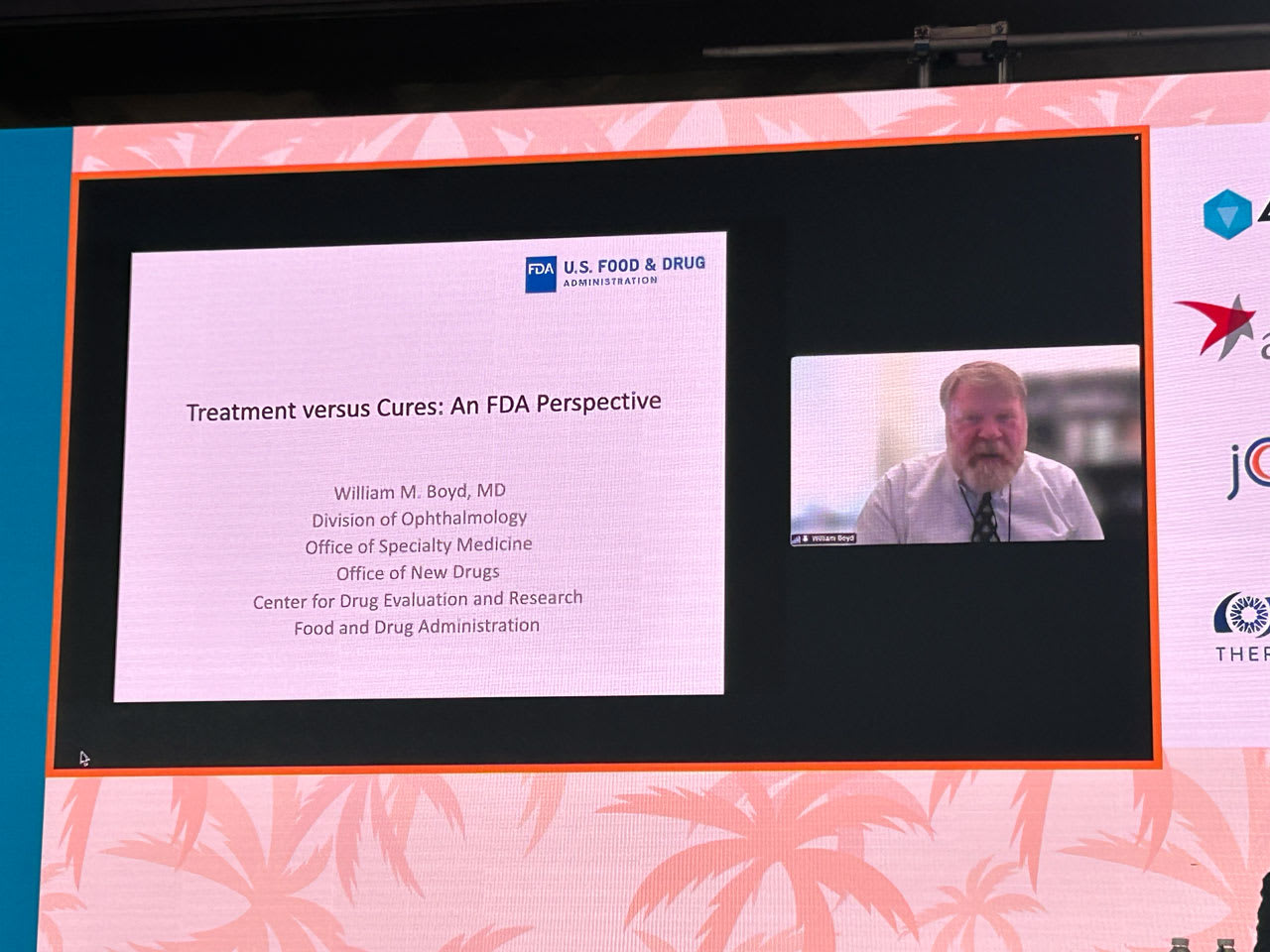While delivering the keynote lecture at the Retina World Congress in Fort Lauderdale, Florida, William M. Boyd, MD, deputy director of the FDA’s Division of Ophthalmology, outlined how his agency evaluates clinical trials and fielded questions from retina specialists on drug development, regulatory processes, and study design.

Dr. Boyd, who has been with the FDA since 1998, assumed leadership of the division following the January 2024 retirement of longtime director Wiley A. Chambers, MD. “For the foreseeable future, I will remain the deputy director because there is a hiring freeze,” he explained. “You cannot select a director, you cannot replace a deputy director for the time being, so I’m it.”
The FDA’s Division of Ophthalmology currently consists of 8 ophthalmologists, who perform a combination of scientific, regulatory, and administrative duties. These include oversight of regulatory review teams and guidance on clinical trial design, endpoints, labeling, and safety/efficacy assessments. Two ophthalmologists who retired at the end of 2024 have not been replaced, said Dr. Boyd. The division also includes an associate director of labeling. The ophthalmology division is supported by FDA experts in chemistry, clinical pharmacology, engineering, safety, legal/policy matters, and statistics.
“I do need to mention that the reduction in force that happened earlier this year affected our administrative staff, our regulatory and policy folks,” said Dr. Boyd. “My direct ophthalmology team is intact, but the reduction of force had an effect on the groups that we work with.”
Dr. Boyd discussed the difference between a treatment, which can manage the symptoms of a disease or slow its progress, and a cure, which eliminates the disease so that it’s not expected to reappear. “We treat the signs and symptoms of geographic atrophy,” he explained. “We have no cure that can result in a reduction in the mean rate of lesion growth. We can slow the progression, but it is not a cure. Same with neovascular age-related macular degeneration. We can have clinically significant improvements in vision, but we are not curing wet AMD.”
All the products that have received FDA approval since 2019 are treatments rather than cures, he noted.
The Division of Ophthalmology was very busy in 2024, and Dr. Boyd described the agency’s workload. “In 2024, we received 6 New Drug Applications (NDAs) that had not previously been submitted,” he said. “We received 2 Biologics License Applications not previously received and not biosimilars. We had 2 NDA resubmissions. We had 3 BLA resubmissions. We had 173 meeting requests [but] you can double that number because we have an internal meeting and then we typically have the sponsor or applicant meeting. In 2024 we had 53 new Investigational New Drug (IND) applications submitted, and that’s in addition to the amendments for the INDs that they already have in-house. So, you can see that we’re remarkably busy although we are down numerous reviewers.”
At the end of his presentation, Dr. Boyd answered questions from the audience. What follows is a selection of some key questions and has been edited for length and clarity:
Q. How does the approach of conducting both a superiority trial and a noninferiority trial, rather than 2 geographically differentiated noninferiority trials, represent a departure from the standard model?
Dr. Boyd: We do not insist that trials be identical. We like to see 2 adequate and well-controlled trials because we want to see replication of efficacy. But we don’t define that as identical trials. From our standpoint, we do not have an objection to trials that are different in design…. We also don’t insist that they both be phase 3. If you have an adequate, well-controlled, well-designed phase 2 trial, you can submit that along with a phase 3…. We’ve had numerous applications where we think an adequately controlled phase 2 trial could replace another phase 3. A phase 2 is as good as a phase 3 if it’s well designed.
Q. Given staff limitations, do you see a role for artificial intelligence (AI) to help speed up approval processes?
Dr. Boyd: Our goal is to have adequate and well-controlled trials and for us to review and to approve safe and efficacious products. I can promise you that there are intra-FDA plans on how to incorporate artificial intelligence. I can't comment on them [at this time], but I presume and hope that we will pursue this because I think it has an important place in the way that we review products….I see a place for AI as part of our work. I just don't think we're there yet.
Q. How do you view the value of early-stage continuity studies in animals when evaluating treatment durability?
Dr. Boyd: Our consideration of the need for animal data is evolving. Currently, we are still requesting animal data. From my perspective, I use that to signal problems or issues that I need to be aware of in clinical trials. I don’t necessarily think that every animal model is perfect or indicative of what we’ll see in clinical trials.
We are open minded. But you’ll see that a lot of times we tend to have the same endpoints in certain classes of drugs because we haven’t been able to see a strong correlation with other endpoints. It’s possible that those specific drugs couldn’t demonstrate efficacy [using that endpoint]. It’s possible their mechanism of action was not appropriate.
We’re happy to discuss with anyone, when they come in for early development, the type of issues that they’re talking about. I don’t think we’re locked into certain pathways or ways of thinking.
Q. Is there collaboration or alignment between the FDA and the European Medicines Agency regarding study endpoints or approval of phase 3 studies?
Dr. Boyd: There is communication. The FDA and Europe have regularly scheduled teleconferences where relevant issues are discussed. When ophthalmic issues are raised, either by 1 group or the other, or by a specific company seeking alignment for some issue, that goes on the agenda. Most of the time we have alignment with Europe. But Europe does not retain ophthalmologists on staff the same way the United States does. They have special medical appointees, so sometimes those things change.
Q. We now have a potential structural endpoint for geographic atrophy. What would it take for a sponsor to get a structural primary endpoint in a retinal exudative disease like wet AMD, DME, or RVO?
Dr. Boyd: I’m going to speak in very broad terms because it gets a little tricky for me to speak about specifics when I have products under development. But I will say that we are certainly looking for a strong correlation with visual function. Frequently, people assume we only look at visual acuity, but we do look at visual fields, contrast sensitivity, and other measures of visual function. In a nutshell, I’m looking for a strong correlation with that change in structure and some aspect of visual function. That’s probably something that is best discussed at a meeting for a specific product, where we can then provide more guidance. RP








